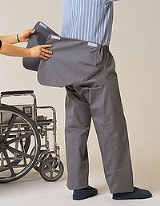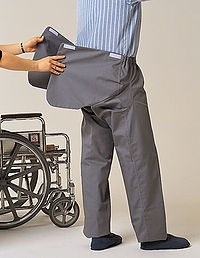
Adaptive clothing
Encyclopedia
Adaptive clothing is clothing designed for people with physical disabilities, the elderly, and the infirm who may experience difficulty dressing themselves due to an inability to manipulate closures, such as buttons and zippers, or due to a lack of a full range of motion required for self-dressing
. Adaptive clothing typically offers rear-closure designs so that an individual can be dressed more easily by a carer. For example, rather than buttons and zippers, Velcro
may be used for garment closures.

, incontinence
and inappropriate behavior issues associated with Alzheimer's disease
. Different styles of adaptive clothing are best suited to an individual with disabilities based on the nature of the wearer's ailment. For example, a person who is unable to lift his arms above shoulder level would need a different clothing solution than a person suffering from incontinence. Special needs clothing can be difficult to find. For that reason, some seek to employ the services of a dressmaker
to transform ready-made clothing into garments which suit their unique needs.
Adaptive clothing products range from clothing protection for dining to tear-resistant shirts and pants. Clothing protector vests are one of the most common forms of adaptive clothing as they are the most adaptable to different conditions. Most contemporary designs attempt to give a sense of dignity to the clothing item by moving away from older terrycloth designs to ones that more closely mimic typical articles of clothing. Adaptive clothing describes but is not limited to: clothing proctor bibs and vests, bandannas, shirts, lapkins, jumpsuits, elastic waist pants, and capes. Companies such as Professional Fit Clothing, Dignified Bibs, Buck and Buck, Silverts, and Adrian's Closet all provide variations of adaptive apparel and incontinence products.
Another important Demographic of society that is rapidly growing is children with special needs such as limited range of motion, impaired dexterity and contractures, G-tube feeding, Wheelchair, Cerebral Palsy, Muscular Dystrophy, Developmental Disabilities, Toilet and changing needs, Catheters and Colostomy bags, IV tubes, Autism and Rigidity.
There are companies that make clothing for children with special needs using the following adaptations: flat seams to reduce friction, discrete adaptions to make the clothing look as normal as possible, easy access with snaps, velcro and stretchy fabric, roomy seat to accommodate diapers for all ages, longer rise in the back to accommodate sitting in wheelchairs, elastic waist for increased comfort and ease in dressing and meeting safety and flammability standards. In addition the same companies can also make custom clothing tailored for specific needs and challenges of each customer.
Some examples of companies that make clothing for children with special needs: Adaptations by Adrian; Mini Miracles Children's Clothing; The Callhans; Talon Clothing.
often causes patients to disrobe at inappropriate times. Adaptive clothing for Alzheimer's patients usually features rear closures
for the purpose of making it difficult to remove articles of clothing without the assistance of a care giver.
Dressing
Dressing may refer to:* Dressing , a medical covering for a wound, usually made of cloth* Ore dressing* Salad dressing, a type of sauce which is generally poured on a salad, or spread on the bread of a sandwich...
. Adaptive clothing typically offers rear-closure designs so that an individual can be dressed more easily by a carer. For example, rather than buttons and zippers, Velcro
Velcro
Velcro is the brand name of the first commercially marketed fabric hook-and-loop fastener, invented in 1948 by the Swiss electrical engineer George de Mestral...
may be used for garment closures.

Special needs
Adaptive clothing often addresses such problems as edemaEdema
Edema or oedema ; both words from the Greek , oídēma "swelling"), formerly known as dropsy or hydropsy, is an abnormal accumulation of fluid beneath the skin or in one or more cavities of the body that produces swelling...
, incontinence
Urinary incontinence
Urinary incontinence is any involuntary leakage of urine. It is a common and distressing problem, which may have a profound impact on quality of life. Urinary incontinence almost always results from an underlying treatable medical condition but is under-reported to medical practitioners...
and inappropriate behavior issues associated with Alzheimer's disease
Alzheimer's disease
Alzheimer's disease also known in medical literature as Alzheimer disease is the most common form of dementia. There is no cure for the disease, which worsens as it progresses, and eventually leads to death...
. Different styles of adaptive clothing are best suited to an individual with disabilities based on the nature of the wearer's ailment. For example, a person who is unable to lift his arms above shoulder level would need a different clothing solution than a person suffering from incontinence. Special needs clothing can be difficult to find. For that reason, some seek to employ the services of a dressmaker
Dressmaker
A dressmaker is a person who makes custom clothing for women, such as dresses, blouses, and evening gowns. Also called a mantua-maker or a modiste.-Notable dressmakers:*Cristobal Balenciaga*Charles Frederick Worth...
to transform ready-made clothing into garments which suit their unique needs.
Adaptive clothing products range from clothing protection for dining to tear-resistant shirts and pants. Clothing protector vests are one of the most common forms of adaptive clothing as they are the most adaptable to different conditions. Most contemporary designs attempt to give a sense of dignity to the clothing item by moving away from older terrycloth designs to ones that more closely mimic typical articles of clothing. Adaptive clothing describes but is not limited to: clothing proctor bibs and vests, bandannas, shirts, lapkins, jumpsuits, elastic waist pants, and capes. Companies such as Professional Fit Clothing, Dignified Bibs, Buck and Buck, Silverts, and Adrian's Closet all provide variations of adaptive apparel and incontinence products.
Another important Demographic of society that is rapidly growing is children with special needs such as limited range of motion, impaired dexterity and contractures, G-tube feeding, Wheelchair, Cerebral Palsy, Muscular Dystrophy, Developmental Disabilities, Toilet and changing needs, Catheters and Colostomy bags, IV tubes, Autism and Rigidity.
There are companies that make clothing for children with special needs using the following adaptations: flat seams to reduce friction, discrete adaptions to make the clothing look as normal as possible, easy access with snaps, velcro and stretchy fabric, roomy seat to accommodate diapers for all ages, longer rise in the back to accommodate sitting in wheelchairs, elastic waist for increased comfort and ease in dressing and meeting safety and flammability standards. In addition the same companies can also make custom clothing tailored for specific needs and challenges of each customer.
Some examples of companies that make clothing for children with special needs: Adaptations by Adrian; Mini Miracles Children's Clothing; The Callhans; Talon Clothing.
Alzheimer's disease
Dementia associated with Alzheimer's diseaseAlzheimer's disease
Alzheimer's disease also known in medical literature as Alzheimer disease is the most common form of dementia. There is no cure for the disease, which worsens as it progresses, and eventually leads to death...
often causes patients to disrobe at inappropriate times. Adaptive clothing for Alzheimer's patients usually features rear closures
Back closure
A back closure is a means for fastening a garment at the rear, such as with a zipper, hooks-and-eyes or buttons. Back closures were once common on Western female clothing, but have recently become less so, especially on female casual and business attire...
for the purpose of making it difficult to remove articles of clothing without the assistance of a care giver.

